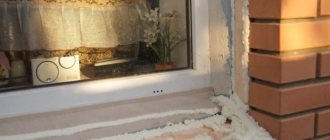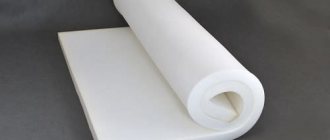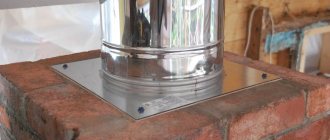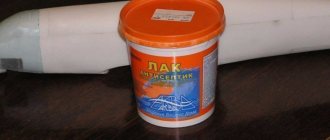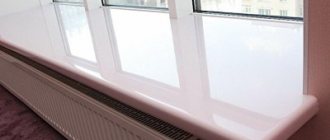Despite the popularity of energy-saving structures made of metal-plastic profiles, there are still many adherents of wooden windows. A number of reasons force one to make a choice in favor of wooden structures: a healthy indoor microclimate, environmentally friendly material, high decorative qualities of the product.
A positive property - the ability of natural material to “breathe”, has another side - increased heat loss indoors. Owners of wooden windows need to take timely care of reliable insulation for the cold season.
RECOMMENDED ON THE TOPIC
- Installation of wooden floors on joists
- What profile for plastic...
Experts have calculated that an apartment loses 30% more heat through the window perimeter than through the same wall area. Which, by the way, can also be insulated. Read about insulating an apartment from the inside.
Places on windows with poor seals can be detected with a burning candle. On a windy day, we will carry it along the window frame, where the flame will fluctuate, there is a place for heat leakage. Such areas must be insulated from the inside and outside of the room.
You can invite specialists to do the work, but it won’t be difficult to do it yourself with the help of improvised materials and special materials.
No. 1. Where does the insulation of wooden windows begin?
Insulation of old wooden windows begins with examining the structure to detect cold bridges , i.e. the main routes of cold air entering the apartment. It is important to find all the weak points in order to carry out comprehensive insulation . The main cold bridges in wooden windows include:
- the junction of the window frame and sash;
- wood from which the frame is made;
- glass;
- slopes, window sills and ebb.
It is better to insulate the slopes, ebb and window sill from the outside, the remaining elements require insulation from the inside, so you will have to work hard to turn an old wooden window into an airtight one that meets current comfort requirements.
If the window inspection and its insulation are carried out efficiently, you can count on an increase in the temperature in the apartment by 3-40C if you are connected to centralized heating, or on significant cost savings if individual heating is used. In addition, it will be possible to get rid of drafts. The other side of the coin is the cessation of natural air circulation. This problem is also typical for sealed plastic windows. Its solution is periodic ventilation or installation of special valves that allow you to regulate the amount of fresh air entering the apartment.
Be prepared for the fact that for effective insulation you will have to use several of the methods described below. Let's start with the technologies that are used for internal insulation.
The best methods of insulation
A wooden window is thermally insulated with sealant, paper, sealants, and polyurethane foam. How to insulate windows is chosen based on the number of cracks found, the condition of the wood and the required degree of insulation. You can make wooden windows as airtight as plastic ones.
Newspaper and paper
Paper for covering windows
A cheap, and sometimes even free, method of sealing cracks in a wooden window. Choose one of the options:
- Paper, preferably white, but loose, not for a printer, is cut into strips 4–5 cm wide. A soap solution or paste is prepared, the strips are lubricated with an adhesive and glued along the junction of the sash, frame and wall. Masking tape provides the same result. In spring, the glued strips are soaked and removed.
- If the gaps are too wide, proceed differently. Newspapers and paper are moistened, rolled into tubes and filled with voids.
- To seal thin cracks in dry wood, paper or newspaper is torn into small fragments, soaked to a pasty state and the cracks are covered with it. Insulation is not removed in the spring.
- Another option is used to seal thin cracks. Small newspaper scraps are mixed with a glass of flour and diluted with water until it becomes sour cream. The composition covers the thinnest cracks that cannot be repaired. The mixture can also be used to seal the gaps between the frame and the wall, for example.
Pasting with paper guarantees a high degree of tightness. To ventilate the room, you need to open the window.
Cotton wool, fabric and tape
Sealing cracks with cotton wool using a sharp object - tweezers, a spatula, a screwdriver.
Cracks and gaps are sealed with technical wool: push the material through with tweezers, the tip of scissors or another sharp object. Then cut the cotton fabric into strips 4–5 cm wide, moisten it with soapy water, wring it out lightly and seal the gaps and crevices filled with cotton wool with the strips. The fabric should be one color, otherwise the window will look sloppy.
You can seal the gaps with masking tape, and use laundry cord instead of cotton wool. The method is more practical. The fabric does not yellow like paper and comes away from the frame much easier. It is also much easier to remove cotton wool from cracks.
Foam rubber
Foam tape for windows without adhesive base
Foam tape is an insulating and lightweight material. Its shelf life is short - 2 years, but the material is cheap. Foam rubber does not deform when compressed, so insulated windows can be opened.
The foam rubber is cut to length, the protective strip is removed and the voids are filled with it or glued at the joint. If the gap is too deep, lay several strips.
The width of the compressed foam strip should be equal to the width of the gap.
Paraffin or sealant
Before applying the sealant, the window is washed, dried and degreased.
A wooden window can be sealed using silicone sealant or paraffin.
For insulation, a moisture-resistant composition with antifungal properties is used. This is usually a polyurethane or theocol sealant. Silicone is squeezed out using a nozzle and filled with voids of any kind. The surface is immediately rubbed to distribute the sealant in an even layer and remove excess. Hardened material is extremely difficult to remove. The result lasts for several years, and doors sealed with sealant cannot be opened.
Another method is molten paraffin. The substance is drawn into a syringe and the gap is filled with it. Paraffin provides the same degree of sealing, but is easy to remove.
No. 2. Insulation of windows with paper
The most ancient, simple and inexpensive way . Today it is rarely used, but it is suitable if the budget is very limited. There are several variations of this insulation method:
- newspapers, wallpaper, paper are torn into pieces, twisted into ropes, which clog the cracks between the sash and the window; to simplify the task, use a ruler, knife, screwdriver or other sharp tools. Some people advise pre-wetting the flagella in water;
- paper waste is shredded, soaked in water and wrung out. To the resulting mass add 1 part clay or 2 parts crushed chalk. The result is a plastic putty that penetrates well even into the smallest cracks.
The classic old-fashioned recipe involves sealing paper insulation with strips of fabric or paper . In order for them to stick well, they were moistened with a solution of laundry soap or a homemade paste was used. The latter can be obtained by mixing water and flour in equal proportions, stirring well and bringing the resulting mixture to a boil.
A more modern option is to use masking tape or special window tape . In this case, the task is simplified, but costs still remain. Windows insulated with paper cannot be opened for ventilation if it suddenly gets warmer in the middle of winter. In the spring you will have to remove the strips of paper/fabric/adhesive tape and take out the insulation. Visible marks remain on the window frames, sometimes even some of the paint is removed, so, unfortunately, you cannot do without updating the decorative coating. However, fabric and self-adhesive paper are the easiest to remove and leave minimal marks.
How to choose?
Before choosing the brand and type of product, the user must measure the required length.
To do this, measure the perimeter of the frame and take an additional reserve of at least 20%.
After this, the width of the gap is measured to determine the desired cross-section of the product.
When choosing a brand, they are guided by the following aspects::
- High levels of moisture resistance and frost resistance, data can be found on the original packaging.
- For self-adhesive tape, it is important to check the expiration date and whether there is a protective film on the adhesive base, otherwise the tape may dry out when stored in a warehouse, losing its adhesiveness.
- High elastic and strength characteristics. You can check the product by squeezing or stretching the tape and cord; if the performance is good, they quickly return to their original shape.
- You need to choose a product according to the color of the window frame, which increases its aesthetic component.
- For products without an adhesive base, you will need to choose high-quality nitrocellulose-based glue or silicone sealant.
- Availability of a certificate for the product, the European brand must comply with SS EN ISO 9001 standards.
Which is better: manufacturer ratings
On the Russian construction market today there are quite a lot of offers for insulation for wooden windows, both from domestic and Western manufacturers. In order for window owners to navigate this list of products and choose the most worthy option, experts advise studying product ratings and customer reviews before purchasing .
Ratings of seals are compiled by large trading platforms based on user demand, taking into account the opinions of an authoritative community.
Since they are grouped according to different criteria, the ratings also need to be considered taking into account the classification of products.
Rating of the best thermoplastic products:
- Monblanc, 20 rub. m.p.
- Ultima, 34 rub. m.p.
- Anchor, 28 rub. m.p.
Rating of rubber products:
- KBE, 35 rub. m.p.
- VEKA, 20 rub. m.p.
- Schlegel, 29 rub. m.p.
Rating of silicone products:
- REHAU SIK, 70 rub. m.p.
- TESA, 41 rub. m.p.
- ASRemWindow, 43 rub. m.p.
No. 5. Insulation of a wooden window with foam rubber and sealant
A much more modern, reliable and effective method of insulation is the use of foam tape and sealing cords.
Foam tape is inexpensive, but its service life is only about 2 years. This method of insulation is optimal when sufficiently large gaps have formed between the sashes and the frame. The installation process itself is simple, but labor-intensive, since everything needs to be accurately measured and carefully glued so that the window is well insulated, but at the same time does not stop closing normally. The main advantage of this method is the ability to open the window.
The process of insulation with foam tape comes down to the following:
- measuring the required length and width of the tape. The length should correspond to the perimeter of the valves, and the compressed width should correspond to the width of the voids;
- the places on the doors where the tape will be glued must first be cleaned of dust and degreased with alcohol or acetone;
- foam rubber tapes are produced, as a rule, with a self-adhesive base, so the task is simplified and comes down to only removing the protective layer and carefully gluing the foam rubber to the designated places;
- Some experts advise additionally sealing the window with paper tape, but this loses the main advantage of the method - the ability to open the window whenever you want. An alternative solution is to glue foam rubber in several rows.
Insulation made using sealing cords . They are made from different materials:
- rubber;
- polyvinyl chloride;
- polyethylene foam;
- polyurethane.
The main advantage of a rubber seal is its price, but when the temperature drops, it can harden and break. In addition, rubber is highly wear-resistant, so it is best chosen for windows that constantly open and close. Although other types of cords are more expensive, they perform much better in terms of operation.
Sealing cords are made in different shapes - the choice depends on the size of the cracks in the window structure:
- a seal whose profile resembles the letter P is suitable for windows with medium-sized cracks;
- seal with a D-shaped profile - for sealing fairly large gaps;
- seal type E - for windows with small gaps.
Tubular seals allow you to achieve a fairly high level of sealing, do not interfere with the free opening of the window, can be left in the summer and serve for several seasons in a row. The seal may have a self-adhesive base and then its installation will be identical to the installation of foam rubber tapes described above. If you take such a seal, pay attention to the shelf life of the glue: if it comes to an end, the cord may either not stick at all or quickly peel off.
The safest thing to do is to take a separate sealant and separate glue for it, which can be used as silicone sealant. In this case, the durability of the insulation reaches 5 years.
There is one more nuance. All work with tubular profiles is carried out at temperatures above +100C, so it is better not to delay it until cold weather. The seal must be glued very carefully so as not to disrupt the opening system of the sashes.
Selection rules
When choosing insulation, you need to consider the following tips:
for wooden frames it is important to use strictly non-flammable material;- much depends on the average wind speed and average temperature during the operating period - not all of the listed products can serve for a long time in severe frosts;
- you need to take into account the width of the slots in the frame. 5-7 millimeters - you can forget about the tape and pay attention to either a self-adhesive seal or putty;
- The product should only be purchased from a trusted store.
Also, when choosing, you should take into account your financial capabilities and skills - some products are quite expensive and require special steps for processing.
No. 6. Insulation of wooden windows using Swedish technology
This is the most progressive, modern and effective way . Windows insulated using Swedish technology are actually equivalent in terms of tightness to modern plastic windows. This method also involves the use of a seal, only for it special grooves are prepared in the window sashes.
Swedish insulation technology involves the following procedure:
- dismantling the sashes;
- cutting thin grooves around the perimeter of the valves, which is carried out with a special cutter; the size of the groove must correspond to the size of the selected seal;
- installation in the grooves of the seal (polyurethane, PVC, polyethylene foam, less often foam rubber is used). No glue is used in this case - the seal holds well due to the thickenings existing in its design;
- applying silicone sealant to the junction of the sash and glass;
- if necessary, fittings and glass are replaced;
- installation of the sashes in place.
The durability of such insulation is 15-20 years , so the labor intensity and high price of the method are fully justified. It’s worth doing such work yourself only if you have at least a little experience in carpentry, otherwise you can only make things worse. The easiest way, of course, is to entrust all the work to specialists.
Windows insulated using Swedish technology can be opened at any time of the year, their appearance does not deteriorate, and sound insulation can be considered an additional bonus.
Seal care
All products must be maintained to prolong their service life. The care procedure is simple and not particularly labor-intensive.
It is advisable to clean not only window frames, but also seals twice a year (before the winter season and, accordingly, before the summer season), without using aggressive chemicals. After cleaning, the seals should be wiped dry and then applied with a protective agent that contains silicone. You can also use glycerin or petroleum jelly (except EPDM). This is necessary to maintain the elasticity of the material.
Silicone grease for rubber seals
Seal lubrication
Advice! If dirty renovation work is being carried out in a room, it is better not to open the windows wide so that dust and particles of construction mixtures do not settle on the seals.
Prices for various types of silicone lubricants for rubber seals
Silicone grease for rubber seals
No. 7. Insulating a wooden window with sealant
This method is aimed at thermal insulation of the junction of glass and sash . It can be done with your own hands, but will require a high degree of care and precision. The procedure is as follows :
- removing glazing beads, thin slats that hold the glass around the perimeter. During dismantling, almost all glazing beads break, so it is better to buy new ones in advance, and with a reserve. Removal begins with the lower bead, then the side ones are removed, and only then the top one; for this it is convenient to use a small knife or screwdriver;
- the seat inside the sash is thoroughly cleaned of dirt and dust;
- applying silicone sealant and installing the glass in place. All work on dismantling and installing glass is carried out wearing thick gloves;
- installation of new glazing beads.
Instead of caulk, you can use window putty . The procedure remains the same, only after installing the glass, excess putty must be immediately removed with a knife. In terms of aesthetics, this method is no worse, since subsequently the joint will still be covered with a new bead.
Tools and accessories
By releasing products for sealing wooden windows, manufacturers made sure that the home craftsman did not need particularly complex or scarce tools to install them . They will be needed to open the frames, remove the glass and thoroughly clean and degrease the surface before gluing the cord or tape.
For the performer, a penknife, a screwdriver, a ruler for measuring the length of the seal, a roller for sealing the cord in the grooves and a construction glue gun will be enough.
To install protective tapes and cords, you also do not need to have special knowledge ; just study the manufacturer’s instructions and purchase the necessary consumables: silicone glue, any degreasing solution and clean rags.
No. 8. Insulating a wooden window with polyurethane foam
Polyurethane foam is used for internal and external insulation ; it fills large cracks well and is used to seal the joints between the frame and the slope, between the slope and the window sill, under the window sill, and between the frame and the top beam.
Working with polyurethane foam is not difficult, but you should know some nuances:
- filling is best done from the bottom up;
- As the foam hardens, it increases in volume, so filling the cracks costs about 1/3;
- work is carried out at air temperatures not lower than +5 and not higher than +300C;
- Polyurethane foam is destroyed under the influence of sunlight, so it must be covered with a layer of finishing material. However, it is unlikely that anyone will leave this material unfinished - it does not look very good.
Instead of polyurethane foam, you can use homemade putty . It is prepared from chalk and gypsum, which are mixed in a 1:2 ratio, and then water is added until a solution of a viscous consistency is obtained. This mixture easily fills all the cracks, and outwardly it looks much more aesthetically pleasing than polyurethane foam.
Purpose of seals
The main function of seals is sound insulation. It is especially important to monitor the condition of window frames for those who have a kindergarten, a busy highway or other noisy place outside their window.
The next, no less important function is protection from dust penetrating through cracks. High-quality seals trap dirt particles, as a result, both the window sills and the entire room remain clean much longer.
The window sill stays clean longer if the seals are in excellent condition.
High-quality seals help maintain a constant air temperature in the house. If the material wears out or becomes deformed, air from the street enters the room through the cracks. In winter, your home becomes colder, and in summer, less comfortable. Instead of turning on the heater or air conditioner, it is better to take care of the condition of the window frames.
Seals are also necessary to maintain an optimal level of humidity in the house. The need to replace seals becomes especially noticeable in rainy weather, when tiny droplets of water seep into the house. Moisture-resistant materials such as rubber and silicone trap steam and droplets from the street.
It is worth taking care of the condition of the seals so that the house is dry and warm
On a note!
Tightness depends not only on the seal itself and the material from which it is made, but also on the type of installation (gluing, etc.). In addition, even the highest quality product can be ineffective if the installation is done poorly. To avoid this, we recommend that you carefully read the step-by-step instructions described in detail below.
Soft and elastic seals increase comfort when using windows. Frames do not slam, close quietly, the risk of deformation of double-glazed windows is reduced and their service life is increased.
Windows will not slam loudly when closing if the seals are soft and elastic enough
No. 9. Heat-saving film for wooden windows
This method is aimed at increasing the thermal insulation qualities of glass , but today heat-saving film is also glued to a wooden frame. It works like energy-saving double-glazed windows, i.e. allows daylight into the apartment, but does not release heat. This film is made on the basis of polyester, and it receives unique properties to reflect thermal radiation thanks to metal coating. This is a transparent material that does not violate the optical properties of window glass, withstands the effects of detergents, is highly durable and makes the window safe, because if the glass is damaged, all the pieces will remain on the film.
The process of installing the film is simple, but it requires care, because it is important to stick it evenly, without bubbles, with the metallized side facing out. It is best to work with gloves so as not to leave greasy marks on the surface.
Thermal insulation film can make a window “warmer”, but cannot be used as an independent insulation material.
Requirements for materials used for thermal insulation
Exactly what requirements the insulation must meet largely depends on its type. The most important rules are the following :
- sealant, putty and other similar products must maintain their original geometric parameters throughout their entire service life;
- tape, self-adhesive seals must have high adhesiveness and strength;
- cotton wool and foam rubber must meet the recommended values of vapor permeability and moisture absorption.
Also, when choosing a material, you need to take into account the design of the windows:
- for wooden frames, it is primarily important that the product is not flammable;
- another important point for such windows is that the material must be environmentally friendly;
- In the case of plastic windows, the “density” parameter must be taken into account.
Additionally, it is important to take into account the climatic conditions that the selected material will have to withstand. For example, paper tape will not cope with strong winds and frosts.
No. 10. We eliminate gaps in the sashes and frames
It is not enough to seal the gaps between the frame and the sashes, and between the sashes and the glass - the window will still let in cold air if there are cracks in the wooden elements . They certainly appear on wood as a result of temperature changes. It is not difficult to eliminate them; the following materials are used for this:
- paraffin. It is heated in a water bath to a temperature of about 700C, drawn up with a syringe without a needle and filled into all the cracks. Within an hour it will harden and turn into a serious barrier to drafts;
- special wood putty;
- sealant, and you can choose the material to match the color of the wood;
- homemade putty made from plaster and chalk, the recipe for which was described above.
Naturally, such thermal insulation measures will be most effective if you first remove the old decorative coating, then fill the cracks, and after that apply a new layer of finishing. Keep in mind that paint adheres worse to paraffin and sealant, so it is better to carefully remove their excess.
Signs of seal wear
On average, seals last up to five years. If the following symptoms appear, you should make an urgent replacement:
- the house has become noisier, extraneous sounds from the street are heard more clearly than before;
- Condensation, ice appears on the windows, traces of mold are visible;
- dust on the windowsills began to accumulate in large quantities, it has to be wiped off more often than once every three to five days;
- the room is uncomfortable, there are drafts and you can hear the wind blowing;
- upon visual inspection, cracks and deformation of the material are noticeable;
- the seal has become hard;
- the heterogeneity of the shade of the sealant is noticeable.
Seal wear
No. 11. How to insulate wooden windows from the outside?
Internal insulation is sometimes not enough. Slopes often need additional thermal insulation . Work on their insulation begins with the dismantling of the old finish, after which the surface is primed. The cracks can be filled with polyurethane foam; another option is to cover the slopes with polystyrene foam. After hardening, excess foam is cut off and the surface is treated with plaster. A polymer mesh is attached to the foam on top, perforated tape is placed in the corners, after which plaster is performed. All that remains is to prime and paint the slopes.
The window sill area is also sealed with polyurethane foam. A mandatory requirement is the installation of a special strip for drainage of rainwater. It should be inclined and have rolled edges so that moisture does not get on the walls or through the window. It is advisable to seal the joints between the plank and frame or slope with sealant.
It is better to insulate the area under the window sill with polystyrene foam from the outside, because in a third of cases the most heat flows away through this area.
The final touch of external thermal insulation is updating the paintwork. The old peeling layer of paint can be removed using a spatula and a hair dryer, and fresh paint or varnish can be applied instead.
Where can the heat come from?
Compared to plastic ones, wooden windows have advantages and are environmentally friendly. With sufficient strength and accessibility, wood structures “breathe.” The porous structure of wood ensures air exchange with the street. Over time, it dries out, cracks and gaps form between the mating surfaces. Through them, during the heating season, part of the heat ends up outside.
Another direction of thermal energy leakage is the loss of tightness between the wall and the frame. This is due to:
- improper installation;
- wear of seals with loss of tightness;
- shrinkage of the structure.
Some more heat is lost through the glazing. For ordinary quartz glass, the thermal conductivity coefficient is 1 – 1.4 W/(m°C). Double-row glazing made of glass 4 - 5 mm thick allows you to cope with the cooling of windows. When installing thinner glasses or single-row glazing, all the heat will be outside. Knowing the main directions of heat loss, it is easy to choose a technology for prevention.
No. 12. Insulation of wooden windows in a wooden house
A wooden house places increased demands on the aesthetics of all work carried out. In principle, you can use any insulation technology, but be extremely careful. It is best to use a transparent sealant for thermal insulation of the junction of glass and frame, heat-saving films, fill large cracks with polyurethane foam and then seal them with casing. An excellent way to additionally insulate windows in a wooden house is to install shutters .
Cover with film
If you have done all possible types of work, but the room is still cold, you will have to use an extreme method - cover the window with film. Yes, it's ugly. But it’s better not very beautiful, but warm. This method is usually used for windows facing the backyard. We take a thick transparent plastic film, stretch it from the outside onto the window, securing it with strips from the street. Not the most aesthetically pleasing window insulation, but effective.
Ugly? But it's warm...
Why does this method work? Because an additional insulating layer of air is created between the film and the outer glass. This is the first point. The second is this. Since the film is usually nailed to the walls, it turns out that cold air does not penetrate to the frame.
Energy saving film
The same effect - an additional insulating layer - also works in the case of the recently advertised insulation of window glass using film. As you know, any room loses heat through walls, windows, roof, floor. Windows account for up to 40% of heat loss. Previously, this problem was solved by installing additional winter frames. Heat-saving film is essentially a modern substitute for such a frame. Thin double-sided tape is attached to the window frame, and a film is glued to the tape. How smooth is not the point. It needs to be heated with a hairdryer (a regular one, not a hair dryer), after which it will level out and be unnoticeable.
Special energy-saving films are sold
This simple method allows you to raise the room temperature by several degrees. The same film will prevent overheating in the summer - prevent the sun's rays from passing through the glass. The only disadvantage of this method is the inhumane price. A square meter of film costs from 350 rubles, plus you will need double-sided tape.
Is this energy efficient film different from regular film? It's hard to say until comparative tests have been carried out. Will anything change if you cover the window with regular plastic film? Hardly. The advantage of this film is that it is crystal transparent and, after heating, is invisible on the window. So this is a relatively inexpensive and easy way to raise the temperature in the room without ruining the view from the window.
Cheaper way
Almost the same effect can be achieved if you stick packaging film with air bubbles on the inside of the glass. Of course, using this film we lose transparency, but the price is not so high. The film is generally very easy to install. We moisten a piece of film cut to the size of the glass with water (from a spray bottle). Water is applied to the smooth side. We spray it on the glass. We lay the film, align it, press it, straighten it with our hands. That's it, the film is glued.
You can do it easier - stick bubble wrap on the inside of the glass
It can last for months. It can be removed without any problems - they pulled the edge and it all came off. The same piece can be used for several years, since nothing happens to it. This is a simple method that makes insulating wooden windows more effective.
The relevance of using insulation for windows
Today, plastic double-glazed windows are installed more often. Their tightness is usually ensured by adjusting the hinges and cleaning the joints. Sometimes this is not enough and you have to use additional insulation. (More details in the article: How to insulate plastic windows) Some still prefer wooden windows due to their more affordable cost and environmental friendliness. For country houses made of wood or timber, it is advisable to use glass frames made of the appropriate material. A clear disadvantage of wooden systems is their poor tightness. Therefore, it often blows from them, even when they are closed. This leads not only to a deterioration of the indoor microclimate, but also to an increase in heating costs during the cold season, and the penetration of dust, pollen, and rain into the house. Special insulating material solves these problems.
Do-it-yourself seal installation
Once the seal is purchased, it can be installed on the window. If you purchased a self-adhesive seal, installation will be carried out as follows:
- The surface of the window where the seal will be installed is well cleaned of dust and dirt. After this, it must be degreased and dried thoroughly;
- you need to determine the place where the seal will be installed - this could be a sash or frame;
The sealing strip can be attached to the sash or frame - the seal comes in a double tape and, if necessary, can be divided in half, then cut into strips of the desired size;
- you need to remove the protective layer carefully, trying not to stretch the tape itself;
- attach the tourniquet around the entire perimeter of the window using gentle pressing movements;
- The window can be used after two hours.
To attach conventional sealing tape, glue or sealant is used
If you purchased a simple seal, then you need to take care of the method of attachment to the frame. You can use rubber adhesive or sealant. Otherwise, the installation does not differ from the method described above. It is worth noting that some ordinary people practice installing such insulation using a stapler. We do not recommend using this method, since the surface of the sash loses its appearance over time .
Types of foam insulation
At the beginning of the article, it was already noted that this material is well suited for thermal insulation of window openings. But it is worth noting that there are different options for foam insulation.
Foam rubber is presented in the form:
- Cut strips;
- Coils (long strips);
Also, when specifying characteristics, the profile size, thickness and height of the strip are often indicated.
In addition, there is self-adhesive foam rubber and insulation without an adhesive base.
Another important characteristic is the density of the material. However, this parameter is rarely specified. If you try the foam rubber to the touch, it should be as elastic as possible. This property will allow it to be used in cracks of different sizes and to “plug” the insulation into even a small crack.
Foam rubber
Foam rubber is an excellent insulation for windows and doors. Used for a long time. It fills the gaps between the door frame and the wall, the sash and the window frame. You can additionally glue a paper strip or tape on top.
Advantages:
- environmental cleanliness;
- does not harm the surface;
- cheapness;
- density;
- ease of use;
- easy to compress.
Flaws:
- allows air to pass through, therefore does not provide complete thermal insulation;
- may come off.
The process of foam insulation is shown in the photo below.

